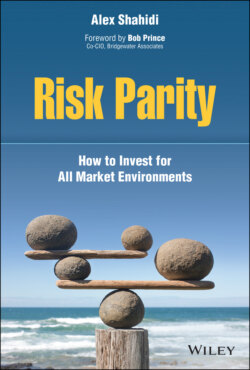Читать книгу Risk Parity - Alex Shahidi - Страница 12
Preface
ОглавлениеA fundamental question all investors face is whether they want their portfolio to be balanced or imbalanced. Framing the decision in this simple way leads to an obvious answer. Why would anyone not desire good balance, particularly when a portfolio can be easily diversified without sacrificing long‐term returns?
Surprisingly, nearly every portfolio that I have observed over the past couple of decades has been poorly balanced. These portfolios are overly sensitive to shifting economic environments, performing brilliantly during good times and underperforming the rest of the time. In fact, it seems that investors have become accustomed to their portfolios rising and falling along with the stock market's wild swings. We cheer on bull markets and suffer through the inevitable downturns as we are all in the market together. Investors have been conditioned to believe that attractive long‐term returns can only be attained by allocating a large percentage of their portfolio to stocks, which can be highly volatile. Those who can't stomach the ride should not participate.
I wrote this book with the aim of debunking this widely held myth. I introduce an easy‐to‐follow conceptual framework that allows for strong balance while targeting long‐term returns competitive with equities. This is not an approach that involves market timing, a sophisticated trading strategy, or the use of esoteric investment vehicles. A simple, fixed allocation across a diversified mix of major asset classes is all that is needed to achieve the objective.
The investment strategy, commonly termed “Risk Parity,” is not something new and untested. Some of the world's most sophisticated institutions have adopted and successfully implemented this approach for several decades. Bridgewater Associates, the largest hedge fund in the world, developed the concepts presented in this book over 25 years ago and has been running a risk parity strategy for its giant institutional portfolios ever since.
It seems that investors' portfolios are not only imbalanced, but that investors don't have a full understanding of what it means to be balanced. I want to share these insights that I have gleaned from the smartest minds in the industry because every investor, large and small, deserves to know. In this book, I attempt to describe the framework in a language that anyone interested in investing will understand regardless of their investment acumen and experience. Over the years, I have had the opportunity to walk through the concepts with a wide variety of investors and investment professionals. With repetition comes an appreciation of the points that resonate and a refined narrative for more complex topics.
Moreover, I feel strongly that investors need more balance today than perhaps at any point in our lifetimes. The potential range of economic outcomes is exceedingly broad, and the odds of extreme results only seem to increase over time. My goal is to equip investors with the knowledge and tools they need to build smarter portfolios and avoid taking unnecessary risk.
